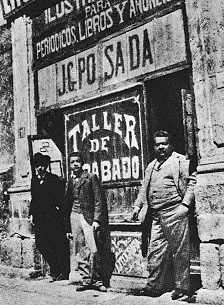José Guadalupe Posada
José Guadalupe Posada (born February 2, 1854 in Aguascalientes , † January 20, 1913 in Mexico City ) was a Mexican engraver and caricaturist who posthumously achieved international fame, particularly through the creation of the character " La Catrina ".
Life
José Guadalupe Posada Aguilar was born on February 2, 1854 in the Mexican city of Aguascalientes. He began his artistic career as a helper in a ceramics workshop and as a draftsman of religious images. In 1866 he learned the art of lithography in the workshop of Trinidad Pedroza and from 1871 worked for the local newspaper El Jicote . A few years later he started working as an illustrator for Antonio Vanegas Arroyo's publishing house in Mexico City and opened his own studio on Calle de Santa Inés (today's "Calle de Moneda"). During this time he worked as a cartoonist and published mainly works that were directed against the government of Porfirio Díaz and the oppression by the Mexican upper class. From the beginning of the Mexican Revolution until his death, he took a stand for the cause of the rebels in his work. Posada was forgotten for the rest of his life and died in poverty on January 20, 1913. He is buried in the sixth grade Panteón de Dolores in Mexico City. Since no one was interested in his remains for the next seven years, they were exhumed in 1920 and taken to a communal grave.
plant
Posada's legacy is very diverse and extensive. Among Posada's best-known works are his calaveras or skeletons, especially “La Catrina”, which he coined with biting sarcasm and black humor on the Mexican upper class before the revolution. It is known that the idea of depicting dead characters who pursue everyday activities completely alive already existed earlier (e.g. with Manuel Manilla ), but the technical perfection of the work is particularly recognized.
effect
The history of Posada’s impact is symbolic of the Mexican Revolution: Throughout his life, Posada was an artist of the people who was ridiculed by academic artists. He was forgotten at the end of his life and died in poverty. He was only rediscovered posthumously. Especially after the revolution and more recently, his works have contributed to the formation of national identity in Mexico.
References from other artists
The Mexican painter Diego Rivera is considered to be the discoverer of Posada - in his autobiography he calls Posada, who was far removed from the Mexican artistic circles, his “most important teacher”. Rivera took up the motif of Catrina in 1947 in his mural “Sunday Dreaming in the Alameda”.
In 1920 the French-born painter Jean Charlot presented Posada's works to the “art-interested” public and at least posthumously helped Posada to be honored.
José Clemente Orozco knew José Guadalupe Posada in his youth and said himself that Posada's work had a strong influence on him.
Tim Burton : There is speculation as to whether Tim Burton wasinspired by La Catrinawhen creating his animated characters in The Nightmare Before Christmas and Corpse Bride : The long bodies, the stately clothing and the macabre portrayal suggest this. The Nightmare Before Christmas also refersto Halloween , which is celebrated the day before Mexican Day of the Dead .
Public perception
The contradiction between life and death is deeply rooted in Mexican culture. Many of Posada's works have recently been associated with the traditional Day of the Dead in Mexico, in particular the figure “La Catrina”. The representations are extremely popular today and can be seen as part of Mexico's identity.
Quotes
- Death is democratic. In the end, they all become skeletons, regardless of whether they were blonde or brunette, poor or rich.
gallery
literature
- Hannes Jähn (Ed.): The Works of / Das Werk von José Guadalupe Posada. 3. Edition. Zweiausendeins, Frankfurt am Main 1997, ISBN 3-86150-242-9 .
- Anton Friedrich (Ed.): Posada . Preface by Hugo Loetscher . Diogenes, Zurich 1979, ISBN 3-257-26007-5 .
- Hans Friedrich Secker (Ed.): José Guadalupe Posada . VEB Verlag der Kunst, Dresden 1962.
- Francisco Díaz de León : Guadalupe Posada y Pancho Cornejo . Bellas Artes No. 7, 1957. (Spanish) ( pdf version )
Web links
- José Guadalupe Posada. ( Memento from January 18, 2010 in the Internet Archive ) (on www.iea.gob.mx; Spanish)
- José Guadalupe Posada. ( Memento from January 31, 2013 in the Internet Archive ) (on redescolar.ilce.edu.mx; Spanish)
- José Guadalupe Posada. ( Memento of April 25, 2007 in the Internet Archive ) at: www.proa.org; An exhibition of the works of JG Posada
- Info and works by Posada ( Memento from September 27, 2007 in the Internet Archive ) (Spanish)
- Literature by and about José Guadalupe Posada in the catalog of the Ibero-American Institute of Prussian Cultural Heritage, Berlin
- Works by José Guadalupe Posada in the digital collections of the Ibero-American Institute
| personal data | |
|---|---|
| SURNAME | Posada, José Guadalupe |
| BRIEF DESCRIPTION | Mexican engraver and cartoonist |
| DATE OF BIRTH | February 2, 1854 |
| PLACE OF BIRTH | Aguascalientes , Mexico |
| DATE OF DEATH | January 20, 1913 |
| Place of death | Mexico city |








